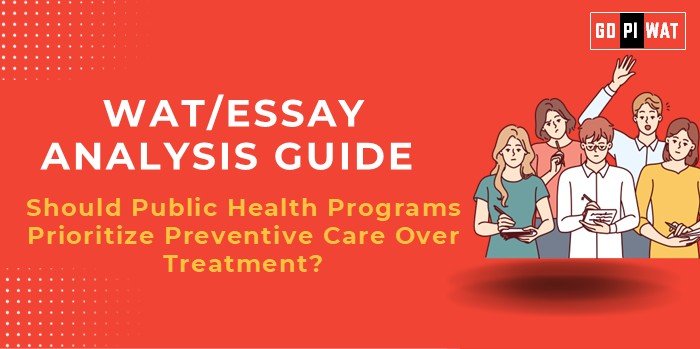📋 WAT/Essay Analysis Guide: Should Public Health Programs Prioritize Preventive Care Over Treatment?
🌍 Understanding the Topic’s Importance
Preventive care directly addresses root causes of illnesses, reducing long-term healthcare burdens. This discussion links to policy-making, resource allocation, and public welfare—a critical intersection for B-school perspectives.
📑 Effective Planning and Writing
- 🕒 Time Allocation:
- ⏱️ Planning: 5 minutes.
- ✍️ Writing: 20 minutes.
- 🔍 Review: 5 minutes.
✍️ Introduction Techniques for Essays
- ✨ Contrast Approach: “While modern medicine excels in treatment, over 60% of global deaths are preventable, underscoring the importance of shifting focus to prevention.”
- 💡 Problem-Solution Approach: “Healthcare systems are stretched thin, but preventive care offers a cost-effective solution to reduce disease burden.”
📖 Structuring the Essay Body
🏆 Achievements
- 📈 Early cancer screenings: Increase survival rates by 25%.
- 🌍 WHO immunization programs: Save 2-3 million lives annually.
⚖️ Challenges with Comparative Analysis
Low participation in India’s preventive programs contrasts with Finland’s 80% success in reducing heart disease deaths.
🚀 Future Outlook
Integration of AI in preventive diagnostics and the role of 5G in rural healthcare outreach.
🔍 Concluding Effectively
- ⚖️ Balanced Conclusion: “While treatment addresses immediate needs, preventive care ensures a healthier future. A balanced strategy is key to achieving sustainable healthcare.”
- 🌍 Global Comparison Conclusion: “India can emulate Finland’s success in prevention by focusing on policies that encourage early intervention and health education.”
🔑 Recommendations for Sustainable Progress
- 💵 Increase government spending on preventive health programs.
- 📡 Expand telemedicine and AI-driven diagnostic tools.
- 🤝 Promote public-private partnerships to enhance accessibility.
📝 Sample Short Essays
1. Balanced Perspective
“Prevention and treatment are two sides of the same coin. However, prevention offers the unique advantage of reducing disease incidence and costs, critical for long-term health sustainability.”
2. Solution-Oriented
“Investment in preventive care yields exponential returns, from reducing NCDs to empowering citizens with health literacy. This shift is not just logical but essential for global health equity.”
3. Global Comparison
“Countries prioritizing prevention, such as Finland, demonstrate reduced healthcare costs and higher life expectancy. India must replicate this model for inclusive health outcomes.”


